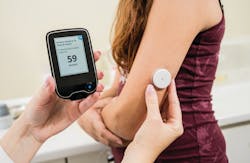The American Society for Clinical Chemistry (AACC) and the American Diabetes Association (ADA) are updating their evidence-based clinical guidelines for diagnosing and monitoring diabetes.
Some of the major areas of revisions or additions involve preserving glucose levels in blood samples, testing in pregnant and postpartum women, the use of continuous glucose meters and managing interferences to HbA1c test results.
The testing guidelines were published previously in 2002 and 2011 in Clinical Chemistry and Diabetes Care. All nine members of the expert committee involved in the 2011 iteration of the guidelines are working on the current effort.
While all guidelines are important, this is particularly true for diabetes testing because it is such a common disease. In 2018, 34.2 million Americans, or 1 in 10, had diabetes and 88 million American adults, or 1 in 3, had prediabetes, according to the Centers for Disease Control and Prevention (CDC). In addition, 7.3 million adults aged 18 years or older who met laboratory criteria for diabetes were not even aware that they had the disease.1
It’s important to not only produce guidelines but to review and revise them regularly. “These guidelines have to be updated regularly as knowledge advances and lab tests improve and management of patients with diabetes improves,” explains David B. Sacks, MB ChB, FACP, FRCPath, Adjunct Professor of Medicine, Georgetown University; Clinical Professor of Pathology, George Washington University; and chairperson of the committee.
Methodical process
However, the process of updating the diabetes testing guidelines is methodical and laborious, and draft recommendations go through multiple layers of vetting before they become final. Work on the current iteration began several years ago but has been stymied by the fallout from the COVID-19 pandemic, Sacks said, adding that he did not want to provide a guesstimate on when the guidelines would be in final form.
The process begins with a committee comprised of experts from both the AACC and ADA. After reviewing and interpreting new medical literature, committee members draft updated recommendations, which are then graded based on the strength of the recommendation and the quality of the evidence supporting it.
A grading system was developed during the 2011 cycle, and the committee is using it during the current guideline-drafting effort, Sacks said. The rating scale ranges from high to very low, and it is described in detail in the 2011 articles.2 The guidelines also include “good practice” recommendations, which are based on expert consensus rather than high-quality clinical evidence from randomized, controlled studies.
Once the committee members draft and grade the guidelines, they post them on the internet for public comment; they then revise the guidelines based on that feedback. After that, the AACC Evidence Based Lab Medicine Subcommittee and the ADA Professional Practice Committee review the guidelines, which are then sent to peer review before they are finalized, Sacks explains.
As of now, the committee is finalizing a set of draft guidelines, which it will post online. In the meantime, Sacks and several other members of the committee spoke about the process and the draft recommendations during an educational session at AACC’s 2021 annual meeting, which occurred in September in Atlanta.
There are numerous areas of the draft guidelines — and Sacks is careful to emphasize their preliminary status — that the committee emphasized during the AACC presentation.
Glycolysis
One example is how to prevent the loss of glucose in blood samples, which occurs as a result of glycolysis, or the process of converting glucose into compounds that generate energy.
To counter that problem, the committee in the 2011 guidelines recommended that lab employees immediately place the sample in an ice-water slurry and subject it to centrifugation to remove the cells within 15-30 minutes. If that wasn’t possible, the committee suggested that labs use a tube containing a glycolytic inhibitor, such as granulated citrate buffer.
However, in the preliminary 2021 guidelines, the committee reversed those recommendations, and now says a test tube containing a glycolytic inhibitor is the best choice. The recommendation also says that tubes with only enolase inhibitors, such as sodium fluoride, should be avoided. Granulated citrate is the optimum inhibitor, the committee says.
However, if the appropriate tubes are not available, the ice-water slurry is a reasonable second choice, according to the 2021 AACC presentation.
“There’s more evidence to support that — a lot of studies have been done using a granular citrate as a buffer and showing that it’s very effective,” Sacks said. “Ten years ago, when we published the previous version of this guideline, that evidence was not available. So that’s a classic example of how the guidelines change in response to new evidence,” he said.
Unfortunately, tubes with granulated citrate are not available in the United States, Sacks said, adding that he is hopeful manufacturers will respond to the recommendation by producing and selling them.
Testing women during pregnancy
Another area of emphasis in the 2021 draft guidelines is diabetes testing in pregnant and postpartum women.
The recommendations are as follows:
- All pregnant women with risk factors for diabetes should be tested for undiagnosed prediabetes and diabetes at the first prenatal visit using standard diagnostic criteria.
- All pregnant women not previously known to have diabetes should be evaluated for gestational diabetes between 24-28 weeks of gestation.
- Women with gestational diabetes should be tested for diabetes 4-12 weeks postpartum using non-pregnant criteria.
Why the emphasis? “Diabetes has such a huge impact on the pregnancy, so it’s important to pick this up and manage patients in the early stages of pregnancy,” Sacks says, noting that many people with diabetes are not aware that they have it. Approximately 30% of women of childbearing age have impaired glucose metabolism, according to the committee’s AACC presentation.
Because women who have had gestational diabetes are at higher risk of contracting type 2 diabetes later in life, it also is important to start monitoring them in the postpartum stage, he says.
Continuous glucose monitors
The committee also focused on continuous glucose monitors. As is often the case with technology, continuous glucose monitors (CGMs) have advanced significantly since 2011.
The continuous glucose meters also now are helpful to a broader range of people. “Since 2011, we’ve also seen a lot more randomized trials of CGM showing benefits in broader populations beyond what we had in 2011 (when we mainly had evidence for benefit in adults with type 1 diabetes.) More recent studies have shown benefit on HbA1c and/or hypoglycemia in teens with type 1 diabetes, older people with type 1 diabetes and a lot of hypoglycemia, pregnant women with type 1, people with type 2 on insulin, and others,” Kirkman said.
When asked why the committee does not recommend the use of the devices to diagnose diabetes, Kirkman said, “One problem is that we don’t know what cut-points we would use. We could get an average for interstitial glucose, but what does that add beyond HbA1c? And accuracy may not be high enough (analogous to not recommending meter glucose to diagnose diabetes). Also, a person has to wear a CGM for 72 hours or more to get enough data to be meaningful in terms of what ‘average’ glucose is. With tests like fasting plasma glucose or HbA1c being so quick, there doesn’t seem to be a good reason to do this.”
HbA1c
HbA1c measurement also is a subject covered in the draft guidelines, addressing the role of interferences that compromise the results of HbA1c tests. The recommendations are as follows:
- Assays of other glycated proteins, such as fructosamine or glycated albumin, may be used in clinical settings where abnormalities in red cell turnover, hemoglobin variants or other interfering factors compromise interpretation of HbA1c test results, although they reflect a shorter period of glycemia than HbA1c.
- HbA1c values that are inconsistent with the clinical presentation should be investigated further, including whether interfering factors are present.
- Comparison of suspicious HbA1c results with other glycated protein assays may be informative.
Common hemoglobin variants include HbS, which leads to Sickle cell anemia; HbC, which causes mild hemolytic anemia and mild to moderate enlargement of the spleen; and HbE, which causes mild hemolytic anemia, microcytosis, and mild enlargement of the spleen.3
HbA1c, which is used to both monitor blood sugar control in existing diabetes cases and to diagnose new cases, also is another perfect example of the importance of standardizing testing processes through adherence to clinical guidelines, Bruns explains. “The difference between HbA1c that is normal and one that isn’t is extremely small. We’re talking about tenths of a percent. We have to be able to hit that level of accuracy day in and day out around the clock, 365 days a year in thousands of clinical laboratories. Standardization is absolutely critical because the analyte itself is difficult to measure,” he said.
Whether it is a recommendation related to HbA1c or another aspect of diabetes diagnosis and monitoring, Sacks says when the guidelines are finalized, he expects that clinical laboratories will revise their testing practices to align with the new recommendations. “As knowledge and technology improves one would hope that clinical labs would incorporate the latest knowledge and the latest testing,” he said.
References
- Centers for Disease Control and Prevention. National diabetes statistics report, 2020. https://www.cdc.gov/diabetes/pdfs/data/statistics/national-diabetes-statistics-report. Accessed October 31, 2022.
- Sacks D, Arnold M, Bakris G, Bruns, D et al. Guidelines and recommendations for laboratory analysis in the diagnosis and management of diabetes mellitus. Diabetes Care. 2011. June; 34(6): e61-e99. doi: 10.2337/dc11-9998
- Sivaraman P. The role of race and ethnicity in variant hemoglobin. Medical Laboratory Observer. https://www.mlo-online.com/disease/diabetes/article/21203094/the-role-of-race-and-ethnicity-in-variant-hemoglobin-traits. December 22, 2020. Accessed October 31, 2021.



